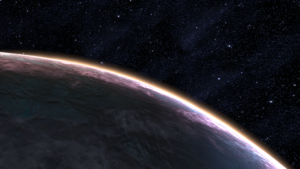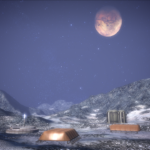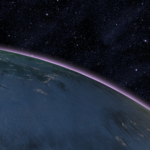System Specs:
- Stellar Mass: 1.692 Sol Masses
- Stellar Class: F0
- Luminosity: >6 Sol
- Planets: 5
- Moons: 0
- Asteroid Belts: 1
- Asteroids: 0
- Objects: 0

Prerequisite: 80% Morality (Mass Effect)
It is probably named for the ‘centaur’ Cacus and is probably a reference to Dante’s Inferno, the first canticle of his Divine Comedy. In the Divine Comedy, Cacus is one of the guardians of the eighth circle of Hell.
Keplerian ratios (a3/T2) may be derived for four of the orbiting planets. Of these, the outer planets Faringor and Treyarmus have the same ratio, which presumably corresponds with the solar mass. The inner planets Chohe and Zayarter diverge from this ratio and from each other.
In Sol’s system, Uranus and Neptune have similar discrepancies from Kepler’s law, although not nearly as drastic. Their discrepancy is due to their mutual gravitational perturbation. Chohe and Zayarter – smaller planets – could be perturbed by an innermost “hot Jupiter” or protoplanetary matter not noted on this chart which make the solar mass seem locally greater than it is from Faringor’s orbit.
Airless worlds Faringor, Chohe and Xamarri at their distance are all too hot for a system with a main-sequence star of this mass; and Chohe’s atmosphere is too tenuous for a planet that massive. It is likely that this star has not yet entered the main sequence. A proto-F0 would have more luminosity; and its planets would still be in the process of differentiation. Also, there is bismuth-208 in Faringor’s core, which implies heavier elements and radioactivity in that planet and in those planets inside its orbit.
–
Planets Directory:
- Zayarter
- Chohe
- Xamarri
- asteroid belt
- Faringor
- Treyarmus
–
Zayarter:

- Orbital Distance: 2.0 AU
- Orbital Period: 2.1 Earth-years
- Keplerian Ratio: 1.814
- Radius: 5,535 km
- Day Length: 53.8 Earth-hours
- Atmospheric Pressure: 0.5 atm
- Surface Temp: 166 °C
- Surface Gravity: 0.7 g
- Mass: 0.523 Earth-masses
An enigmatic terrestrial planet, Zayarter has a hazy atmosphere of nitrogen and argon. The surface is scorching hot, and mainly composed of calcium with deposits of sodium.
Three times in the last century, ships stopping to discharge at Treyarmus reported geometric patterns of lights on the dark side of Zayarter. Attempts at further investigation proved fruitless; the lights disappear when ships approach the inner system.
–
Chohe:

- Orbital Distance: 3.7 AU
- Orbital Period: 5.4 Earth-years
- Keplerian Ratio: 1.737
- Radius: 8,000 km
- Day Length: 54.5 Earth-hours
- Atmospheric Pressure: 0.00 atm
- Surface Temp: 11 °C
- Surface Gravity: 1.0 g
- Mass: 1.562 Earth-masses
- Satellites: 1
Chohe is a terrestrial planet whose surface is mainly composed of aluminum, with numerous deposits of calcium. Though it has enough mass to retain a dense atmosphere, Chohe is nearly a vacuum. This lack of atmosphere allows a moderate average temperature, but the differences between night and day are extreme.
The surface of Chohe’s sunward-facing side is usually covered by a haze of volatiles (mainly water vapor and carbon dioxide), which return to the ground as frost over the course of the long, cold night.
The Sirta Foundation has established a research outpost on Chohe to investigate the native subterranean life of Chohe, which shows incredible resilience to extremes of heat and cold.
–
Xamarri:

- Orbital Distance: 13.03 AU
- Orbital Period: 36.1 Earth-years
- Keplerian Ratio: 1.698
- Radius: 2,236 km
- Day Length: 42.1 Earth-hours
- Atmospheric Pressure: 0.00 atm
- Surface Temp: −117 °C
- Surface Gravity: 0.19 g
- Mass: 0.023 Earth-masses
Xamarri is a small, airless, cratered terrestrial – a lifeless rock quite similar to Luna. Its frozen surface is mainly composed of silicates, though one hemisphere has several “seas” of dark basaltic rock.
Properties
The orbital distance here is a minimum derived from Kepler’s equation, the cube root of constant 1.691 × 36.12. This constant is the solar mass 1.691 derived from the two outer planets, and assumes the orbit is not perturbed like the two inner planets. Given a slight perturbation its semi-major axis could be greater than 13.04 but if so, most likely negligibly.
However its surface albedo as calculated from parameters, including this distance, is −1.81. Mass Effect’s description offers no offset for this impossibility. Based on Faringor’s description (and the system’s relative youth) there may be residual radioactivity in the planet’s core.
–
Faringor:

- Orbital Distance: 20.2 AU
- Orbital Period: 69.8 Earth-years
- Keplerian Ratio: 1.692
- Radius: 11,129 km
- Day Length: 69.6 Earth-hours
- Atmospheric Pressure: 0.00 atm
- Surface Temp: −144 °C
- Surface Gravity: N/A g
- Mass: N/A Earth-masses
- Satellites: >2
A large but low-density, terrestrial world, Faringor is generally believed to consist mainly of water ice. Occasional upwelling of metals, caused by the interacting tidal forces of several large moons, suggest the core is small, but extremely dense.
Faringor has a thin atmosphere of carbon dioxide and ethane. Its frozen surface is mainly composed of dark carbon-laced water ice.
Ten years ago, Faringor’s grim surface color and dim illumination drew the cinematographer Risa Uvarsen to film the exterior scenes of “Starless” on location. Acknowledged as a masterpiece of gothic horror, the sets — well preserved by the vacuum — draw hundreds of tourists to the backwater system every year.
Assignments
Survey: UNC: Valuable Minerals: Rare Element ×1 (Polonium)
Properties
Its surface albedo as calculated from parameters is −2.15. Presumably the tidal effects from its moons and residual radioactivity from its core are providing additional heat. This escapes from the mantle by means of petroleovolcanism: spontaneous oil gushers. Between the core and the frozen surface is a thick layer of organochemical / water sludge. However the oil’s intense radioactivity dissuades mining interests from further investigation.
–
Treyarmus:

- Orbital Distance: 51.75 AU
- Orbital Period: 286.7 Earth-years
- Keplerian Ratio: 1.686
- Radius: 42,211 km
- Day Length: 12.8 Earth-hours
- Atmospheric Pressure: N/A atm
- Surface Temp: N/A °C
- Surface Gravity: N/A g
- Mass: N/A Earth-masses
Treyarmus is a hydrogen-helium gas giant with a strong magnetic field, making it a popular discharge point for freighters working on the Anansi-Ishtar shipping route.
It is popular enough, in fact, that quarian ships can often be found loitering in orbit, selling the freighter crews cheap refreshments, salvage, and odd craftworks assembled by their children. There are no ships in orbit at present, however.
Properties
Treyarmus is too small to be a “hydrogen-helium gas giant” (William Hubbard, The New Solar System 4th ed, 1999; p. 194). It is more likely a dense “ice giant” like Neptune or Gliese 436 b.
–
–
video









